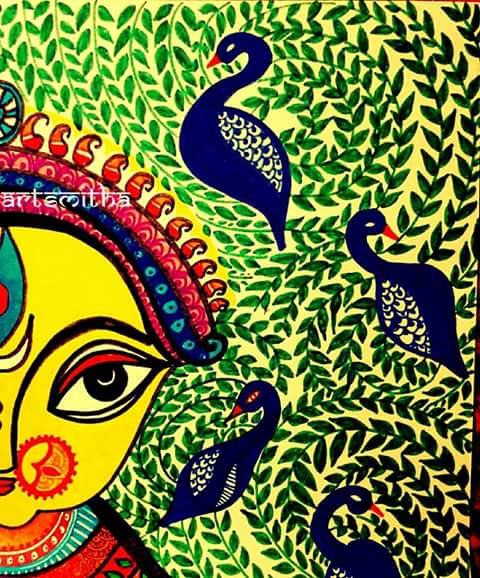
[This piece of article is provided by Ms. SONAM DHINGRA who is a prominent art teacher at City Vocational Public School, Meerut, by profession and an artist herself. She has done in-depth research on indian arts and crafts.]
Madhubani district occupies an area of 3501 sq Kms. This district is bounded by a hill region of Nepal and extending to the border of Darbhanga District in the south, Sitamarhi district on the west and by supaul in the east. Madhubani fairly represents the centre of the territory once known as Mithila and the district has maintained a distinct individuality of its own.
Generally it is hold that way back in 2000 B.C., the Aryans could cast their influences on the Indians. Beginning their journey from the Central Asia, the Aryans came to the Kashmir valley through relatively plains routes. In the beginning, few Aryan – settlements took place in the pasture lands, located in Punjab region, because they could get enough for their domesticated animals. But one of the Branches of Aryans came to the Gangetic –Plains – With the help of the Ganges; they came up to the Mithila – region by crossing river Gandak. Thus, the kingdom of Mithila came in to being.
According to the Arthavaveda, that Nomadic – race settled down in Mithila – region. Over the last 3000 years, the warlike Mongols and Persians made several invasions on Mithila – region. The new marital – relationship took place and an inter- mingling of different race too occurred. Under these circumstances, it is difficult to say whether the people of Mithila could retains their original racial identity or they looked different from their neighbours. However, they kept intact their ancient tradition of art and painting.
The population census 2011 says that the district had a population of 4,476,044 of which male and female were 2,324,984 and 2,151,060 respectively.
The rhythm that the word “Madhubani” – generates, have an old anecdote attached to it. Centuries ago, the bees might have been making their hives in the jungles that lay near to the village- subsequently, the villagers regularly extracted “Madhu” or honey before the arrival of rainy season. Hence the place came to be known as “Madhubani”. Tilling the earth, in those days of hoary past, was not a very easy job, for to grow crops, the people had to depend totally on nature god. They needed grace of the god for good crops. Hence, “Madhu” or honey was the only thing that could provide sweetness in their lives.
